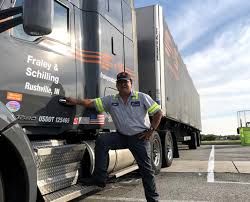
September 29, 2020
By: OMNITRACS
VP OF PRODUCT MARKETING
“You bet!” Mike Posz, Safety Director at Fraley & Schilling, commented enthusiastically. “Like everyone, the pandemic hit us hard. But we changed our business model and have come back better and stronger. This safety achievement is just one piece of the success pie.”
Safety is critical to Fraley & Schilling’s business. Unfortunately, once COVID-19 hit, it was – as Mike described – the wild west on our roads. “We were excited to see law enforcement re-engage in July. They became recommitted to enforcing safety on the highways and we’ve been one of the beneficiaries. Having a great safety month compliments our operational efforts.” 
What is a DOT-Recordable Accident?
The federal Department of Transportation (DOT), which oversees the FMCSA, requires motor carriers to follow certain procedures for keeping track of serious accidents involving commercial motor vehicles (CMVs). An accident that meets the DOT’s criteria for getting recorded is known as a “DOT-recordable” accident.
The definition of a DOT-recordable accident and the rules for recording them are encoded in §390.15 of the Federal Motor Carrier Safety Regulations (FMCSR). If an accident involving a CMV results in any of the following, it must be recorded on an accident register:
- Fatality;
- Bodily injury in which that person receives immediate medical attention away from the scene of the accident; or
- At least one of the vehicles involved in the accident had to be towed from the scene
The DOT does not consider fault or preventability with respect to DOT-recordable accidents. However, earlier this year, FMCSA established the Crash Preventability Determination Program, which allows for the evaluation of preventability of eight categories of crashes. Learn more about the program and how video can prove a driver was not at fault when involved in a crash.
The DOT determines a carrier’s accident frequency by multiplying the number of DOT-recordable accidents by 1 million, and then dividing that number by the number of miles driven in the past 12 months. The resulting number is used as the basis for the carrier’s safety rating in an audit.
DOT-Recordable Accidents: a Case Study
Although Fraley & Schilling is continually focused on safety, the last time it experienced a Zero DOT-reportable accident was November 2019. That started the company moving in the right direction. “We began seeing all our measurables improve. Together, they help drive an overall safety improvement.” This comes on a history of improvement.
In the first 18 months of installing the SmartDrive video-based safety solution on all company-owned trucks, Fraley & Schilling saw a 67% reduction in its collision frequency rate. With a deep, sustained commitment to safety, the company continued to see meaningful impact from the SmartDrive program. Along with cementing the company’s culture of safety, the SmartDrive program allowed Fraley & Schilling to realize a cost savings of two cents ($.02) per mile driven due to reducing collision frequency and being able to more efficiently allocate resources.
But these improvements didn’t just happen. “You don’t get to zero without putting in the work,” commented Mike. To emphasize his point, Mike noted that, through mid-August (32 weeks into the year), the fleet has:
- Had 156 coaching days
- Coached 2,539 events
- Averaged 16.3 drivers coached every day
This was all accomplished during the pandemic. “We had to adjust but we didn’t take our foot off the pedal. If you want to continue seeing results, you must continue expecting – and requiring – results,” Mike stated.
But this wasn’t the only area where Fraley & Schilling made adjustments. Once the pandemic hit, drivers began driving different miles with different lengths of haul. When its customers started shutting down, the fleet began planning loads like it did 10 years ago. “We had a new set of customers, along with hauling loads for people who we hadn’t hauled for in five years,” Mike commented. “Different miles. Different customers. Different types of haul.”
Mike gives a lot of credit to SmartDrive in helping the fleet improve safety fleetwide “As our fleet got safer, we encouraged our drivers to get even safer. As a result, we were able to lower our safety score target from 100 to 75 to 50 and now 30. We changed the areas to evaluate and improved our coaching. I’m happy to say that our drivers were on board throughout this journey.” (The SmartDrive Safety Score is an objective measurement of specific driving habits, including speeding, seat belt usage, distracted driving and others.)
“I also have to give a shoutout to SmartDrive’s support team. Yes, they were there when we deployed the system, but they’ve been with us every step of the way. We couldn’t ask for a better safety partner,” commented Mike. “I also have to give credit to our drivers, along with our terminal and safety managers. The drivers are the reason we hit zero. That number aligns with the culture we developed – zero is the expectation. Through coaching, engagement and inspiration, we are able to hit that goal … and plan to continue hitting it, month after month.”
Mike encourages other fleets to get on board with video. “Most companies are hoping and praying that they’ll get through the day without a collision. Why wait? You’ve got to plan today to prevent the accident that might happen tomorrow.”
